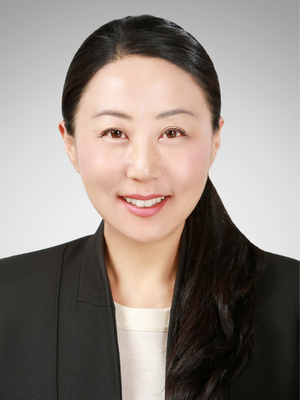Fiona Cho: COO of Asia-Pacific Region, PGIM Real Estate
 “The twists, turns and detours are not a waste,” says Fiona Cho. “They can bring you valuable learning and opportunities. If you have a strict career plan, be open to be a bit more flexible – what if you go left for a while, or right for a while, and not fixate on sticking to a plan?”
“The twists, turns and detours are not a waste,” says Fiona Cho. “They can bring you valuable learning and opportunities. If you have a strict career plan, be open to be a bit more flexible – what if you go left for a while, or right for a while, and not fixate on sticking to a plan?”
Cho talks to being fearless, speaking up, supporting the voices of others and her intrigue for the details of how ecosystems work, from baskets to buildings.
From Liberal Arts to Real Estate to Asia C-Suite
With a passion for material culture (arts, crafts, design, architecture, urban planning), Cho mastered in and envisioned a career in academia focusing on the history of art and architecture, but soon realized she wasn’t suited for a solitary, stationary life. And her intrigue was forward-looking.
So Cho left academia to explore the dynamic “built environment” of the real estate world. She spent seven years in real estate equity research and two years in investment banking at Wells Fargo in San Francisco before taking an investment funds Portfolio Manager role with PGIM Real Estate based in Singapore, focusing on the Asia-Pacific region, nearly fifteen years ago.
“I didn’t go to business school” says Cho. “But I think the twists and turns and nonlinear path have given me experiences, perspectives and insights that help me to be both a better fund manager and a better leader.”
Cho likens being a regional portfolio funds manager to running a small company – working with people in various functional groups and areas of expertise across different countries to understand a client’s needs, craft and manage the strategy, and hit the investment targets. She is proud of her funds’ strong performance and how the industry and PGIM are bringing ESG and DEI principles into investment decision-making to fuel positive impact.
Being Fearless In Your Voice
“I have a kind of fearlessness. I can enter a completely new career or opportunity, and I’m quite fearless about it,” says Cho. “Of course, I do have my angst too, but I get into the work.”
While her strong work ethic has always propelled her success, the corporate world revealed that hard work alone isn’t enough to advance – elevating your voice is critical. Cho recalls an early experience when she had worked on a project analysis and presentation across several weeks, only to watch a male team member bluffing as the expert in the big meeting.
“I knew the matter inside and out, and I knew he was speaking on the fly, but I didn’t speak up or make my points,” remembers Cho. “And I went home and didn’t sleep well that night. I had to consciously become more vocal and express my views. You need to speak up and be visible so that your hard work bears fruit and is noticed.”
Cho has since watched too many women who are prepared and hard-working, and often perfectionists, back down from speaking up for their work in a big meeting and be frustrated later.
“You should feel comfortable and confident that you can speak up. You might not say everything perfectly or you might even say something wrong, but that’s okay. Plenty of people will talk and know less than you do,” advises Cho to mentees. “I bring my own unique perspective to the table. Adding my voice may steer the conversation or decision-making in a certain way, or add more nuance to the overall discussion.”
She also advises to be patient and give yourself a break: “Women can beat up themselves for days when something doesn’t go in an ideal way, whereas I see a more easy-going, forgiving attitude towards oneself by some men – and we can embrace more of that.”
The Art of Inclusive Leadership
“Being a leader in the C-suite requires more patience and listening than just managing funds,” she notes, as she’s had to elevate her vision to having the right people and supporting them to move the entire region forward. When it comes to inspiration, Cho feels she has integrated traits she’s admired from various individuals into her leadership style – from how someone led a meeting to how someone practiced inclusion to someone’s way of expressing their expertise on a topic.
“The technical expertise is, in a way, the easiest part of whatever you do. It’s the more intangible, personal things – like how you make teams come together and inspire each person – that are more mysterious and harder to learn,” she says. “Being influential, getting people to feel comfortable sharing their views and to ultimately trust you as a leader. When you see someone do that with grace and ease, it’s an art.”
Cho has lived ‘difference’ all her life. She grew up in the U.S. as an Asian woman of Korean descent after immigrating at five. She stepped into an industry dominated by men. Now she lives in Asia but is far from fluent in the Korean language. She’s attuned to creating space for all voices.
“As a manager or a leader, you have to create those spaces for people who are more quiet or less vocal to speak up,” says Cho. “By doing that, they become more comfortable and engaged in the conversation.” One way she might call in an underrepresented voice is to say, You and I were talking about this point last week. What do you think?
Cho served as the head of the Asia-Pacific region in the global PGIM Women’s Leadership Network that evolved to become the Inclusion Leadership Network. She appreciates PGIM’s strong DEI commitment – such as hiring practices that include both a diverse slate of candidates and diverse, multi-functional interviewer panel. She notes maintaining that DEI focus becomes more important at top levels, where diversity is needed.
“We continue that lens in the career development and career management process,” she says. “We have to recognize that we all have bias, and we don’t know our blinds spots, but we have to work to recognize that and support the less visible and less vocal individuals.”
Ecosystem Lens: From Baskets to Buildings
Cho is an enthusiast for traditional crafts, and her travels in the Asia-Pacific region are rich with opportunities to explore the industries of textiles, baskets, ceramics and more. From the context of production and the detailed work of the craft to the ultimate usage of an object and the socioeconomic impact on people, communities and the world, Cho is fascinated by the ecosystem of material culture. She’s drawn to find ways to support and preserve the cultural traditions that often underpin the livelihood of those women and their families.
Basket to building, the same curiosity about the eco-system of a basket informs her analysis into a property – “Why is it here? Who funded it? Who is using it and for what? How does it impact the community? What are the returns—both financial and non-financial?” Going further, “How will ESG and digital transformation change the ways we organize, use, and invest in physical space, entirely?”
Indeed, Cho’s outlook is both interconnected and forward-looking.
By Aimee Hansen


